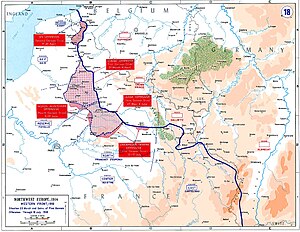
Back معركة المارن الثانية Arabic Бітва на Марне (1918) Byelorussian Бітва на Марне (1918) BE-X-OLD Битка при Марна (1918) Bulgarian Eil emgann ar Marne Breton Druhá bitva na Marně Czech 2. slag ved Marne Danish Schlacht an der Marne (1918) German Segunda batalla del Marne Spanish Marneko bigarren gudua Basque
This article needs additional citations for verification. (May 2009) |
| Second Battle of the Marne | |||||||
|---|---|---|---|---|---|---|---|
| Part of the Western Front of World War I | |||||||
 German offensives, 1918 | |||||||
| |||||||
| Belligerents | |||||||
|
Entente Powers: |
Central Powers: | ||||||
| Commanders and leaders | |||||||
|
|
| ||||||
| Strength | |||||||
|
44 French divisions 8 American divisions 4 British divisions 4 Russian divisions 2 Italian divisions Total: 58 divisions 408 heavy guns 360 field batteries 346 tanks |
52 divisions 609 heavy guns 1,047 field batteries | ||||||
| Casualties and losses | |||||||
|
|
168,000 casualties (including 29,367 captured) 793 guns lost[2] | ||||||
The Second Battle of the Marne (French: Seconde Bataille de la Marne; 15 – 18 July 1918) was the last major German offensive on the Western Front during the First World War. The attack failed when an Allied counterattack, led by French forces and supported by several hundreds of Renault FT tanks, overwhelmed the Germans on their right flank, inflicting severe casualties. The German defeat marked the start of the relentless Allied advance which culminated in the Armistice with Germany about 100 days later.
- ^ Keith Hart (1982). "A Note on the Military Participation of Siam in WWI" (PDF). Journal of the Siam Society. Retrieved 19 July 2015.
- ^ Peter Hart, The Last Battle: Victory, Defeat, and the End of World War I, p. 22.